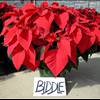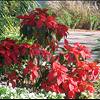This plant may be available to buy
Click the banana to see

|
Poinsettia click pic to enlarge Zone 9-11 or Houseplant The classic Christmas plant, Poinsettia, Euphorbia pulcherrima, is native to Mexico and the Aztecs called the plant "Cuetlayochitl." Today in Mexico the Poinsettia is called Flor de nochebuena (Christmas Eve Flower) The Poinsettia is named after Joel R. Poinsett, the first U.S. ambassador to Mexico. Poinsettias were brought back as cuttings to South Carolina about 1828 In Mexico, Poinsettia is a perennial flowering shrub rated to about 10-15 feet tall. The color you see are not flowers, but colored bracts (modified leaves) just like colors of bougainvillea vines Growing Poinsettia is a big industry today representing about 85% of potted plant Christmas season sales. The USA exports about 90% of the world's Poinsettia plants. It is thought that Poinsettia is grown commercially in greenhouses in all 50 states and over 60 million plants are produced for sale. Purdue University maintains a list of named varieties for 2003
Joel R. Poinsett died on December 12 which is marked as National Poinsettia Day
click pic to enlarge / used as hedge Contrary to conventional wisdom, Poinsettia is not a poisonous plant. A Ohio State University study showed that a 50 pound child could eat 500 bracts and might have a slight stomach ache However, the white sap can have allergic properties, especially for folks who have latex allergies. The Poinsettia, Euphorbia pulcherrima, is a relative of the Brazilian Rubber Tree from which we harvest latex. Contacting the sap, those affected can get a rash, hives, sneezing, coughing, tight throat and possibly difficult breathing. Almost all reactions are mild For outdoor plants, prune heavily in August. By the time December arrives, you'll have plenty of tip growth from which bracts will form color for you click pic to enlarge Indoor care for Poinsettia plants is easy First, many Poinsettia plants are sold with a decorative brightly-colored aluminum or plastic pot wrapper. That's nice, but both aluminum and plastic block water drainage. You need to remove the wrapper or punch holes for drainage Poinsettia plants are extremely brittle. Handle with care to not snap branches. Place your plant in a bright area (best) away from all cold air (like doors) and all cold drafts. Otherwise, cool indoor household temperatures are just fine Poinsettia plants like to be kept on the dry side. Water as often as needed, but allow soil to get dry before watering again, then soak the soil. Be 100% certain all excess water is drained away, so use of pot trays means you have to empty the tray completely Best is to water (soak the soil) in your sink without the tray, then replace the tray. For best performance, however, never allow your plant to wilt due to lack of water Food is not necessary if your Poinsettia is a Christmas holiday plant. If kept throughout the winter, you can feed in the spring, and periodically until early October If you wish to grow your Poinsettia for the next Christmas, cut back your plant in spring (April is a good month) and feed. Outside of zone 9-11, place in eastern sun (only) or general shade after you have reliable temperatures above about 60 degrees. You can also re-pot at pruning time into a larger pot. Keep the plant pruned and pinched (all summer) to produce the main branches you want with plenty of growing tips (from which you get color). You could also severely prune again (you already did in April) in fall, about September As fall approaches, bring your plant indoors to a bright location when temperatures threaten to go below 60 degrees. Starting the end of September or the beginning of October, to initiate color change, place your Poinsettia in complete darkness 12 hours per day. Zero light usually 5:00 PM until morning light. During the day (the other 12 hours) provide as much bright light as possible
Close to Christmas, you will see your Poinsettia's color
return |



